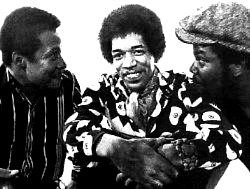greater control over the direction of his music; he spent considerable time working the consoles in the
studio, with each turn of a knob or flick of the switch bringing clarity to his vision. [However] throughout
1968, the demands of touring and studio work took its toll on the group. In 1969 the Experience
disbanded.
The summer of 1969 brought emotional and musical growth to Jimi Hendrix. In playing the
Woodstock Music & Art Fair in August 1969, Jimi joined forces with an eclectic ensemble called Gypsy
Sun & Rainbows featuring Jimi Hendrix, Mitch Mitchell, Billy Cox, Juma Sultan, and Jerry Velez. The
Woodstock performance was highlighted by the renegade version of "Star Spangled Banner," which
brought the mud-soaked audience to a frenzy.
Nineteen sixty-nine also brought about a new and defining collaboration featuring Jimi Hendrix on
guitar, Billy Cox on bass and Electric Flag drummer Buddy Miles on drums.
Performing as the Band of Gypsys, this trio launched a series
of four New Year's performances on December 31, 1969 and
January 1, 1970. Highlights from these performances were
compiled and later released on the quintessential
Band of Gypsys album in mid-1970 and the expanded
Hendrix: Live At The Fillmore East in 1999.
When they hit their first notes at the Fillmore East, remembered bassist Billy Cox, “we didn’t know
what to expect from the audience and the audience didn’t know what to expect from us, but from the time
we hit that first note, they were in awe” because the band combined rock and rhythm and blues (R&B)
together to form a unique sound (Band of Gypsys album notes). Furthermore on the Band of Gypsys
album, Hendrix’s style of playing can be heard as paying homage to his influences. For example, “in it, B.
B. King-style guitar lines and elements of Muddy Waters’ style (signature riff figures) and Wes
Montgomery’s mannered approached (octaves and other double stops) are fused with the rock idiom.
Listen especially to ‘Machine Gun’ and ‘Power of Soul.’ Echoes of Little Richard, albeit faint, can be
heard on the ‘Changes’ vocal.” (Floyd 1995:202).
During the time of the Band of Gypsys' formation, African Americans were in turmoil, fighting for
their civil rights. On one hand, there were the Black Panthers who in October 1966 proclaimed in their 10-
Point Platform and Program that they wanted;
Freedom...power to determine the destiny of [the] black Community...full employment, decent
housing, education, and the liberation of all black prisoners from all prisons and jails. And [their]
major political objective, a United-Nations-supervised plebiscite to be held throughout the black
colony in which only black colonial subjects will be allowed to participate, for the purpose of
determining the will of the black people as to their national destiny (Draper 1970:100).
At the same time the Student Nonviolent Coordinating Committee in 1966, with its new chairman,
Stokely Carmichael, was demanding for blacks to gain control of the black ghettoes in order to obtain
“black self-determination and black self-identity...to enter the open society” [to change] “local or
nationwide patterns of oppression-instead of from weakness” (Draper 1970:122). Memories of Freedom
Summer including sit-ins, bus boycotts, and getting blacks registered to vote, all appeared as themes in
soul music. [In fact at the time] soul music essentialized African Americans' efforts in gaining their
freedom from societal oppression, and in the process helped black people to gain a collective Afro-
centric identity together.
When reorganizing his band from having two Caucasian guys playing with him, to having two black
guys playing with him, Jimi realized that something was missing from his music, a black audience. Since
black music artists were singing about the soul and essence of black people, where did that leave Jimi
and his rock 'n' roll music which was labeled as experimental, psychedelic, and white? Jimi was left
without a noticeable black audience.
On the one hand some blacks now took a notice to Jimi because he now had his friend Buddy
Miles play drums for him. Blacks knew Buddy Miles for his song “Them Changes,” and had only heard
about Jimi Hendrix. But when finding out that Jimi and Buddy were playing together, blacks began to
listen to the Band of Gypsys. As said in Live at the Fillmore East documentary, more blacks will listen to
the Band of Gypsys album, then branch out to Jimi’s other albums. [Going into further detail about this
subject], Eddie Kramer, Jimi’s studio engineer said, “blacks like the Band of Gypsys because of its
funkiness, [and] earthiness.” Jimi felt the Band of Gypsys was necessary to help himself become
connected to black people, instead of the alienation he felt from them.
Blue text comes from (http://jimi-hendrix.com/biography.html)
Green text comes from Shalondra Brown's, From Black To White, Crossing Over in Music


